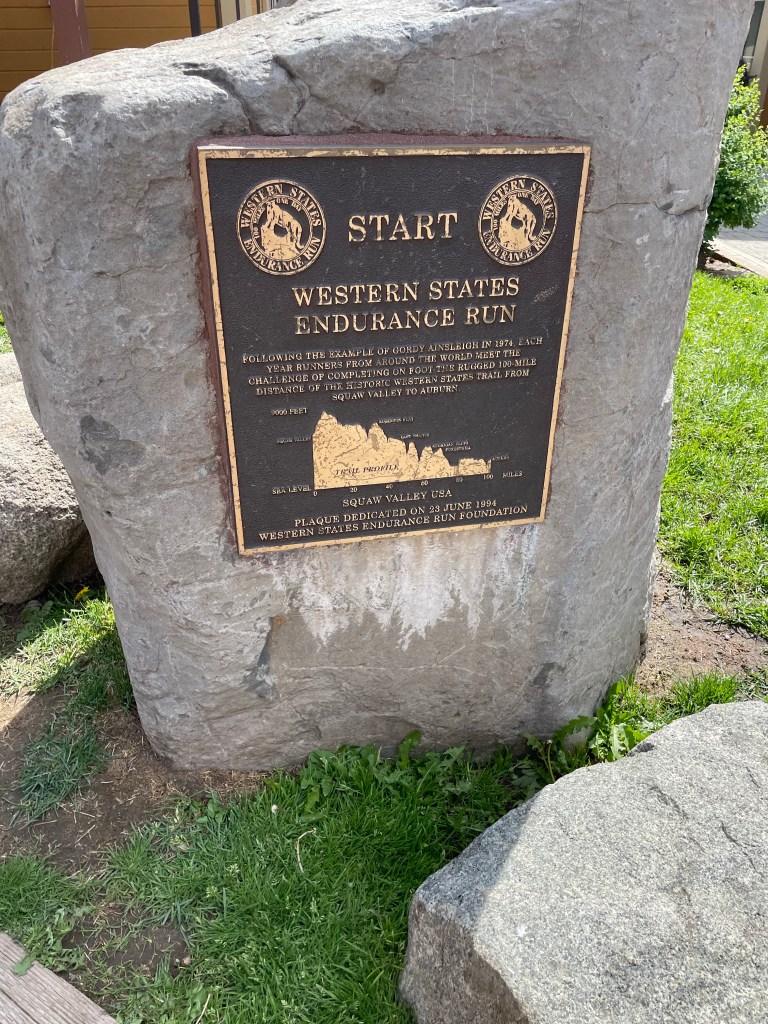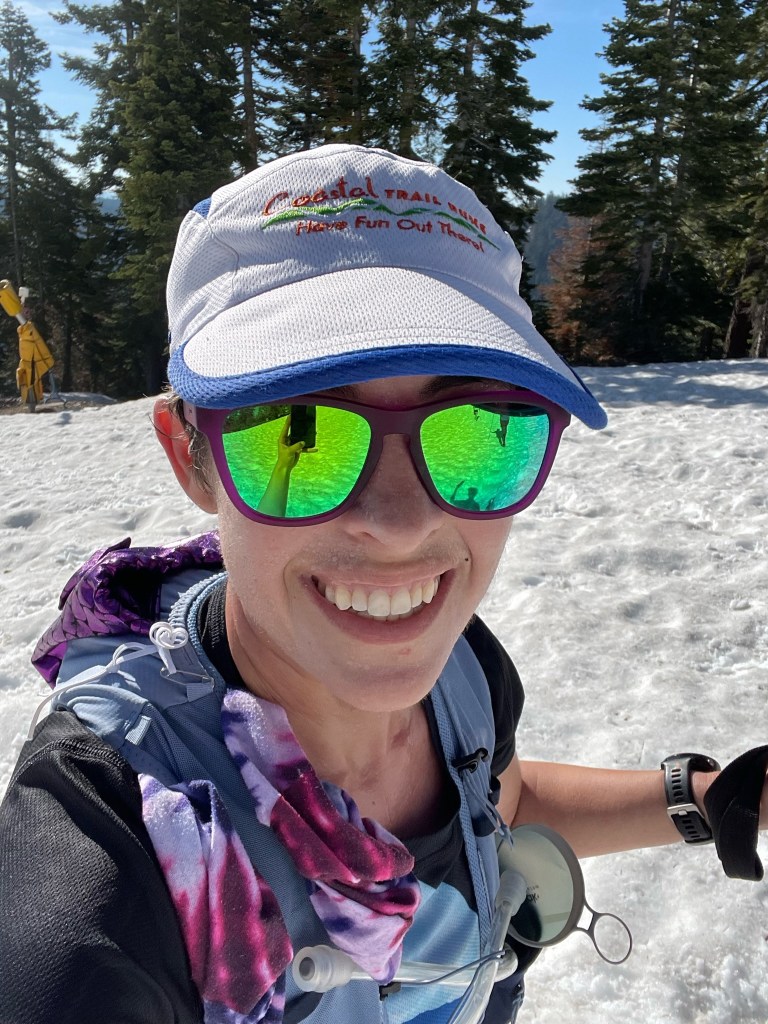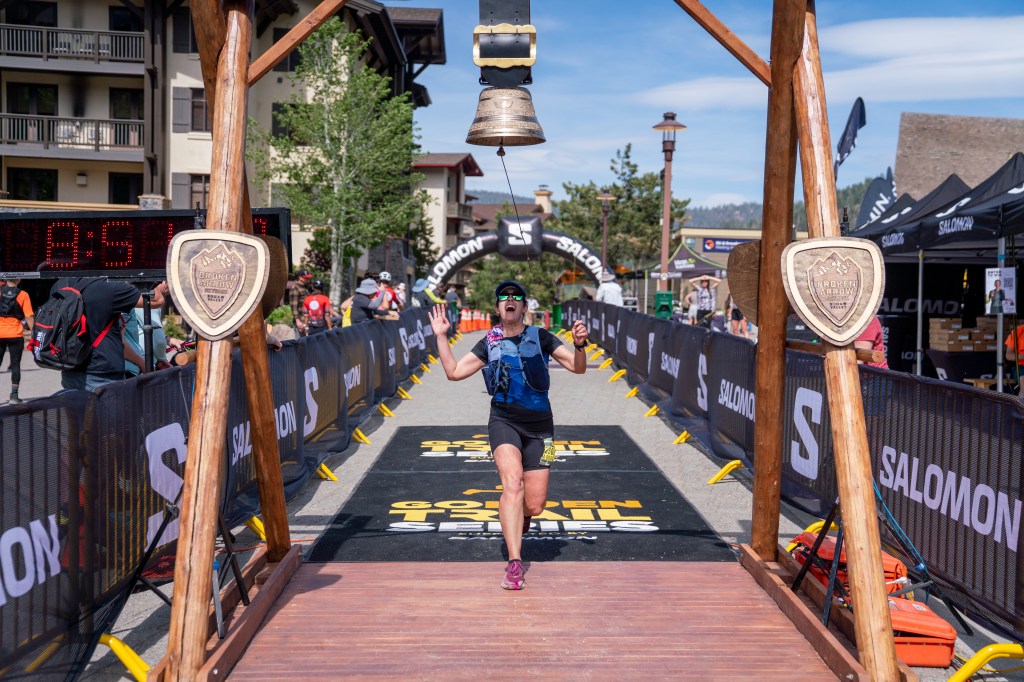Before the Race
Last week, I ran the Broken Arrow Skyrace 46k with a handful of friends. Overall, it was a very hard race – definitely my hardest at this distance. However, the whole weekend was great – spending time with running friends at Lake Tahoe was wonderful.
The Broken Arrow race series includes a number of distances, including a vertical kilometer (VK) on Friday, a 46k on Saturday, a 23k on Sunday, and some other races we didn’t run. Eric and Kate ran the VK; Stephen, Eric, and I ran the 46k; and Eric and Kate ran the 23k.
The 46k, the only race I ran, takes places at Palisades (formerly Squaw) at Tahoe. As such, it’s at altitude (tops out around 9-10,000 feet high) and has some absurd amount of climbing – about 10,000 feet total of climbing. The two-loop course profile looks like this:

This year the race also featured extensive snow – both on the ascent and descent. California got a lot of precipitation this year, and not all of it has melted.
The considerations I had for this race include:
– not enough training due to injury recovery (plantar), which I am glad to say I’ve finally (mostly) fixed
– not enough vertical climbing in training
– insufficient gear for snowy, steep conditions (e.g. spikes, poles)
– altitude / oxygen availability
In terms of training, I only had about two months of real running training ahead of this race, due to (1) plantar preventing me from running and (2) training for the triathlon in April. My training for this race consisted of 2 blocks of 3 weeks each, with weekly mileage around 55-70mpw, and an easier week in between those blocks.
I prioritized running trails with a lot of climbing / steep hills. During the week, that meant the local trails; my backyard has 1,000 feet of climbing over 3 miles, which is about half as steep as the 46k, but very conveniently located despite not being steep enough. On weekends, I looked for long runs with climbs about as steep as the 46k, which meant a bit of driving. Eric, Kate, and I also exchanged run profiles for the training runs we were doing, and seeing what they were training on was quite helpful to calibrate and very motivating.
I spent a lot of time thinking about gear. The two question marks were poles and spikes.
Poles: I don’t like to use poles, but 4/4 people I asked said to use them, and the race itself highly recommended them. Eric loaned me some of his, and I made a quiver (a bag for poles that you attach to the back of your running vest) so I could store them when I didn’t need them. Despite my hesitance to use the poles, they ended up being the single most useful piece of gear I had – not sure how I would have finished this race without them.
Spikes: I brought two pairs of spikes and ended up using neither of them. I didn’t even bring them on the run. Everyone I talked to – from a guy who market the course to people who ran the VK – said they weren’t needed, and this ended up being right.
With all of this – especially the lack of training at altitude, and the high requirement for climbing – I was estimating that I could probably finish around 9 hours.
The weekend of the race: we drove up on Thursday, because Kate and Eric were running the VK on Friday. Stephen and I walked with them to the start line, then watched the live stream – the highest parts of the 46k also featured some of the same parts of the trail, including the snow steps and the ladder (more on that later). After they finished, we all met famous ultrarunner Courtney Dauwalter (as of this moment, she’s about an hour away from breaking the Western States course record), grabbed food, and then took it easy at the cabin for the rest of the night by watching documentaries about climbing Everest.
The morning of the race, I woke up around 5:30, and we left the house around 6:15. The race started at 7, but the cabin was conveniently only 10 minutes of walking from the start, so that left us plenty of time to get down there, hand off some gear to Kate, and get to the start line.
Part 1: Up
The first part of the race was quite nice. The first couple of miles are through a low forest with single-track trail, with climbing that wasn’t too steep. I was feeling the effects of the altitude a bit, so I was taking it slow, which meant I was stuck in a bit of a conga line for much of this part of the course.
After a few miles, the course opens up into a steep meadow – see below for a picture. I was amazed at how steep it was – surely, I thought, this was the steepest climb in the race. In fact, this was one of about 10 similar climbs – each progressively more challenging due to altitude, angle of ascent, and snow.
Miles 4-8 of this course were definitely the hardest for me. I was struggling quite a bit – I was not sure if I was going to be able to do this loop a second time. The main issue was the altitude – I was breathing really hard, and the lack of oxygen to my brain was making my critical thinking skills and fine motor skills less strong than they should have been. This was problematic because the top of the course requires some scrambling and is quite technical, and a mistake could have bad consequences.
Examples of the technical terrain during this section include
– a scree ridgeline with steep drop-offs on each side
– 2x vertical rock faces that required use of hands
– the “stairway to heaven” ladder, which is a literal ladder tilted at a weird angle – see below for Eric on the ladder. This required my full concentration to not fall off of. Fortunately, when I got there, there was a bit of a line, so I had to pause for 5-10 minutes, which allowed me to catch my breath. This was the highest part of the course and I really needed the rest at this stage.
– the snow stairs, immediately following the ladder – see below for those photos too
I really needed the poles on this whole part of the course. They were invaluable and I’m not sure how I would have finished without them.
I’m not embarrassed to admit that, in my mind, I compared these miles to climbing Everest more than once – mainly because we had just been watching the documentary. The altitude, snow, and line at the final ascent all felt similar, even though I’m sure climbing Everest is not really comparable to this race.
All of this combined to really knock my confidence. I was honestly not sure it would be a smart idea, given the challenges, to do the loop a second time. I was worried that I would be more tired on the second lap, and might slip or make a mistake in some way, and this course is not one where you would want to make a mistake. I decided I would get to the bottom of the lap before making a choice to continue.


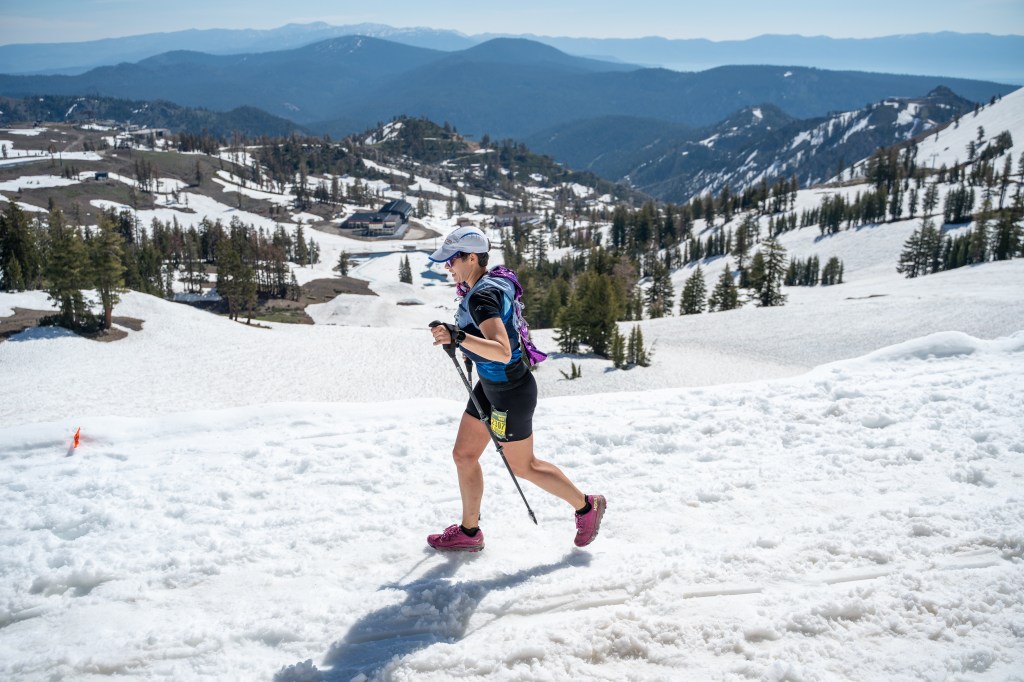

Part 2: Down
I was so relieved to get to the top of the course. I knew that going down meant more oxygen the further I got from the summit.
I was a bit worried about the volume of snow – almost all of this section would prove to be on snow – and this is where I would be most likely to want to have spikes. I had left my spikes with Kate at the beginning of the race, so I was sort of stuck with whatever conditions were on the mountain.
These miles were my favorite on the course. The downhill snow was actually really fun, and easy to run or slide in.
Running in snow: great. I found I didn’t really need the poles for the less steep parts, and instead just picked up my feet, landed on my heel, pointed toes forward, and slid a bit forward with each step. Someone compared it to skiing – she compared it to skiing as she blasted by me at 2x the speed I was going – so her strategy seems to have been an effective one. Even though I’m a terrible skier, I tried to emulate “skiing” to the best of my ability for these parts.
Sliding in snow: also great. An excellent feature of this section was the downhill glissading. There were some parts of the course that were so steep that it was possible to just sit down and slide for a couple of hundred yards. There were some chutes that had been made for this purpose, which were what we used. It felt like a pretty cold waterslide, and you could get up to a pretty good speed.
You can see below for pictures of me glissading – these are from the second lap, when a guy behind me took a video – but it was the same course.
Two guys brought plastic bags to sit on, like sleds, for this part – they were FLYING down the hill.
After all the glissading, there was a 0.5 mile uphill, then a gentle downhill for a few miles to the start/finish.
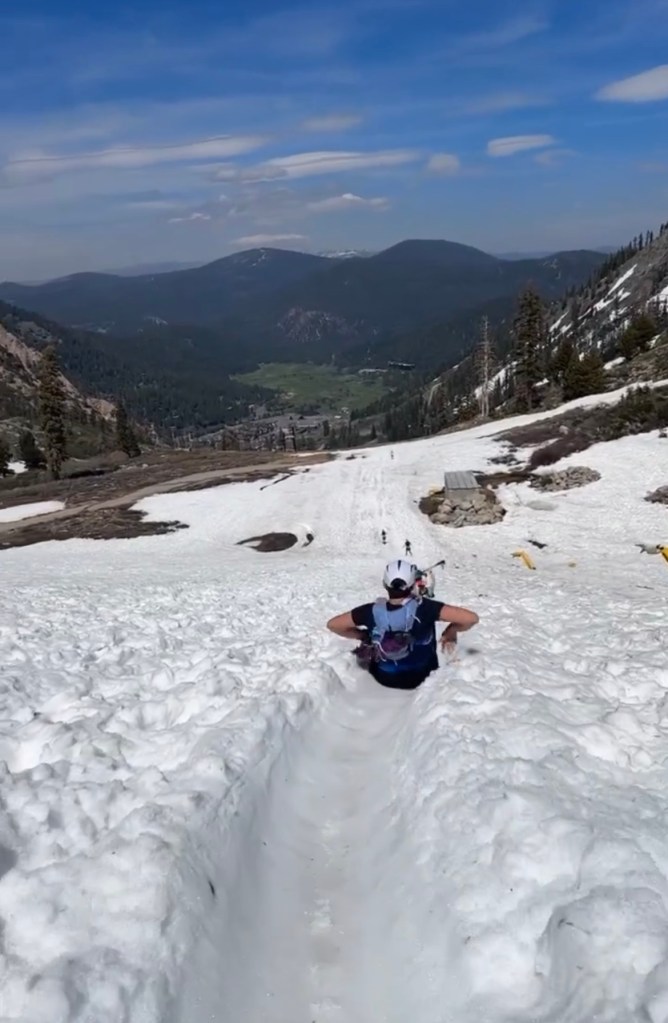
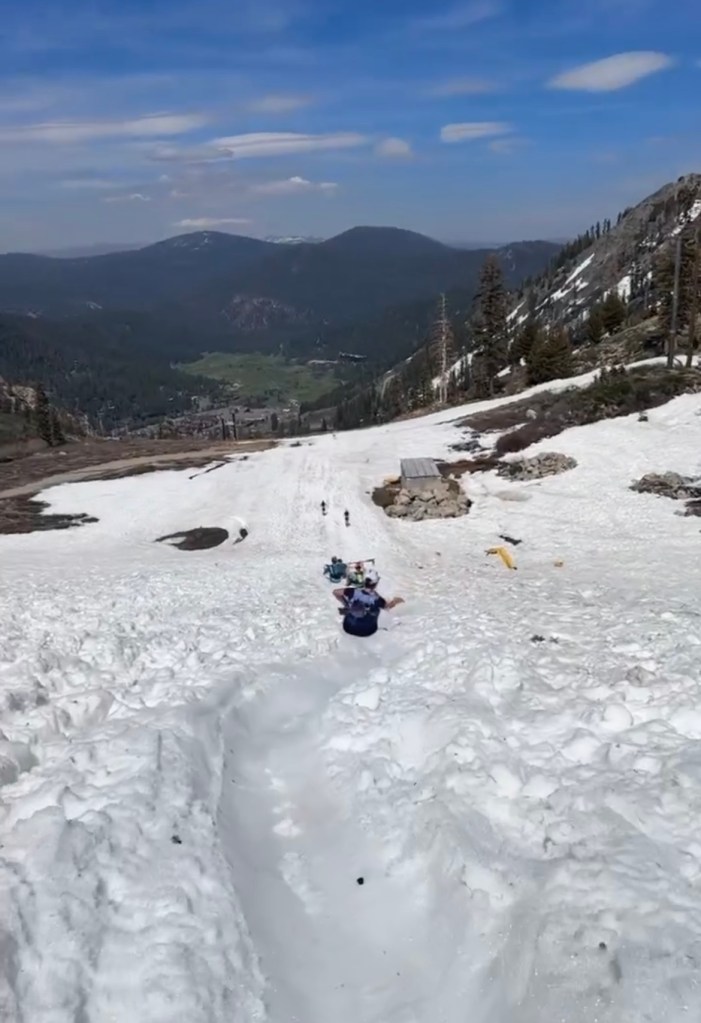
Part 3: Up again
For the first couple of miles, I powerhiked a lot of the forested area.
I felt GREAT at the start/finish area – a.k.a. the halfway point – so I decided I would keep going and just take it really easy on the uphill.
When I got to the hills, I mentally divided each section into the number of major ascents I thought there were based on what I remembered from the last loop – four before the first aid station, and five between the first and second aid station (at the peak). This helped with the mental challenge of knowing how much climbing was coming and gave me something to anchor on.
On the hills, I went the pace I could reasonably go without completely running out of breath. This meant I was passing some people and being passed by others – but I was really narrowly focused on maintaining a pace that made sense for me.
I also focused on counting my breaths in increments of 20, which helped if I needed to take walk breaks or stop. I would run for 100 breaths, then slow down / walk for 20 breaths. I would also guess how many increments of 20 it would take to get me to the next milestone – e.g. a turn in the trail, or a tree – which gave my brain something to do that wasn’t too hard but still distracting.
All of this ended up working well – when I got to the top, I was thinking more clearly and felt stronger than on the first lap, and I wasn’t massively off of the pace I had for that first lap. I felt good, and was ready for the downhill.
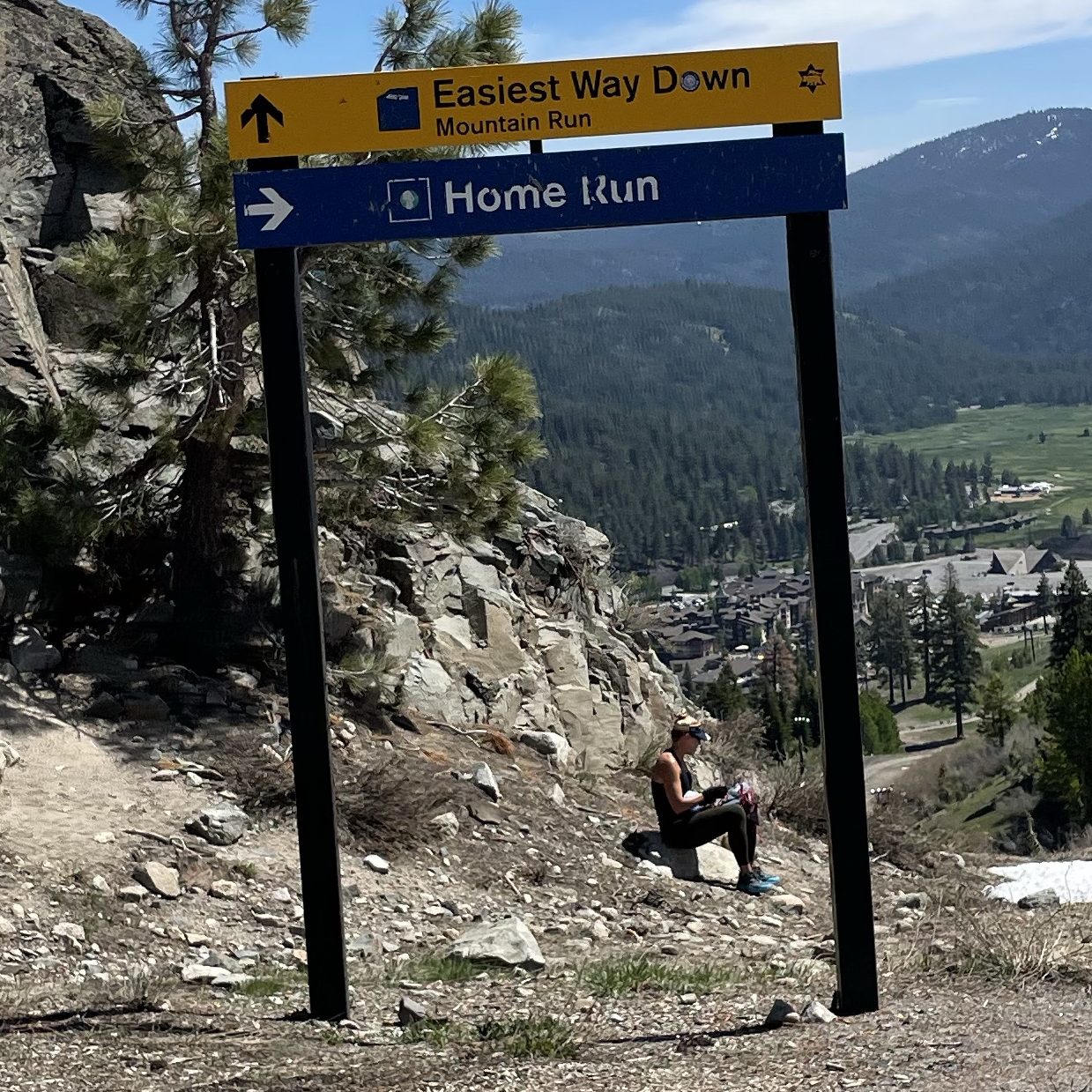


Part 4: Down & Finish
The rest of the race was easy and fun. My downhill running was better than the first lap, and the glissading was just as fun the second time.
When I got to the third aid station, I put my poles away – for the first time during the race.
The last three miles were a gentle downhill – I fell a few times, I think because the adrenaline was wearing off – and made it to the finish around 8:50 – just under the nine hours I had estimated.
After
I wasn’t feeling great after the race – was pretty tired, my lungs were overworked, and my stomach was a little unsettled. I found a patch of grass to lay down behind – right behind the Western States start plaque, so that was kind of neat. We all eventually headed back to the cabin, cleaned up, and got food.
Things that were hard about this race: The race itself was shockingly challenging – in that I was literally surprised by how hard parts of it were, and therefore a bit grumpy on the course. The altitude in particular was really difficult, and if I were to do this again, I would work in some training at altitude ahead of time.
Things that were great: I really enjoyed getting to spend four days with friends at what was effectively a running festival. I liked being able to support Eric and Kate on their races. Also, staying with other runners made race logistics much less stressful. Everyone wanted to eat early and go to bed early. I knew we were all going to get to the start line and I didn’t need to worry about if we were going to be late, which is something I definitely worry about when with non-runners or less-well-organized runners.
Overall, this was a positive experience and I would do it again.
In terms of what’s next – I was thinking about doing another race in the next month or so, but I may take it easy on racing until August (Burning Man 50k). I want to focus a bit more on getting my speed back up again, and being able to do that without the pressure of an immediate race sounds appealing.
